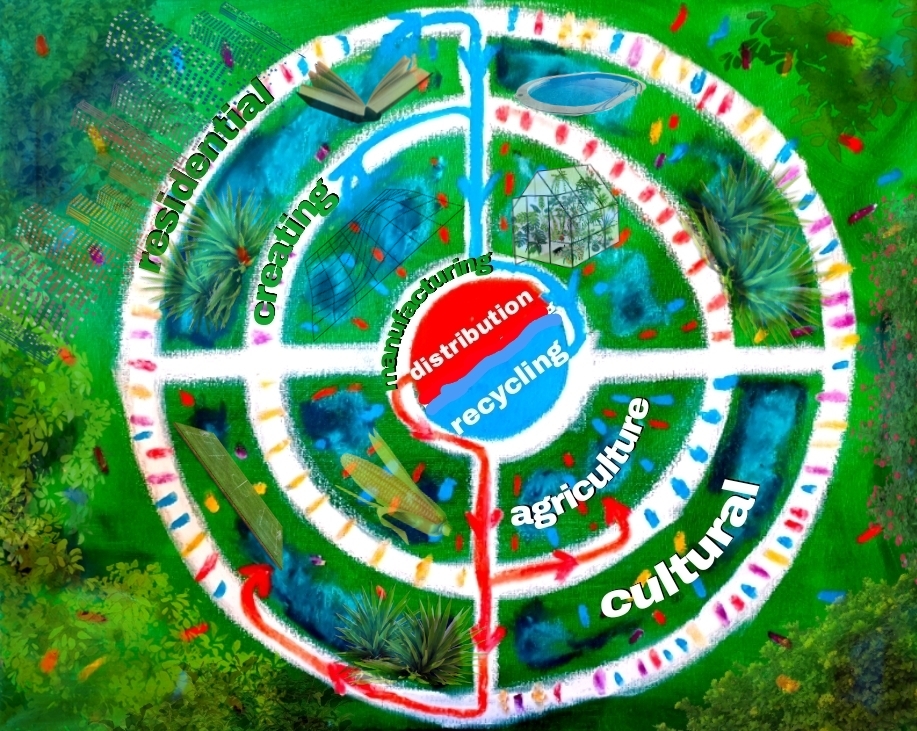“…A feminist perspective that understands that we cannot simply reform institutions like prison and the police, because they are so embedded with racism and violence that, if we’re ever going to extricate ourselves from that, we have to abolish prisons.” – Angela Davis
The issue is public health.
“Injustice anywhere is a threat to justice everywhere.” – Dr. Rev. MLK Jr.
White privilege oppresses black life. Systemic inequality destroys community.
When we recognise ourselves as a neighbourhood, our unity is undeniable. Our economy does not do justice by this truth. Our economy is a false economy.
The word economy comes from the Greek word, “oikonomia”, which literally means management of the household. But in a malthusian* market economy, where everything is for sale, including public health, in the name of privatised profit –
We see a global situation, in which the entire house is being depleted of its resources in order to over-furnish the attic – to the point of collapse.
There are no winners in war.
“We are all one, and if we don’t know it, we will find out the hard way.” – Bayard Rustin
Oppression is coded into the framework of our culture. While the manufacturing and distribution of resources is controlled by a centralised group external to the community, and everything is for sale, the dream of economic equality will remain but a fleeting illusion to be pursued, but never attained.
Economic initiative must be returned to communities. Privatisation must end.
Money – a device of oppression, a mechanism for furthering the access gap via the market-economic separation of debt from money.
“Consider a small island with 100 inhabitants. Each gets $100 loan from the bank. This means $10,000 has been created as the island’s total money supply. Everyone buys goods and services, exchanging money and generating “economic activity”. This $10,000 in loans could technically be returned to the bank, fulfilling society’s loan obligations, removing all money from existence. However, if interest is charged, more money needs to be returned than what actually exists.” – Peter Joseph
Interest is always charged. In this way, communities and entire regions of the globe are disenfranchised into debt and locked into a cycle of division as we compete to sell our labour for currency. Communities are oppressed to varying degrees, with white-presenting, cis gendered folk systemically experiencing more economic liberty directly and indirectly from the oppression of everyone else.
The results are devastating, particularly when we observe the darkening effect this has on the mental skies of our children.
“To change something, build a new model that makes the existing model obsolete.” – Buckminster Fuller.
In the name of public health through access equality, I advocate a –
Open access – open source – zero waste – cybernetic – resource economy.
Currently the world operates under a
Privatised access – closed source – extractive – cybernetic – market economic module.
In the early 70’s, Stafford Beer pioneered Project Cybersyn in Chile – this sought to facilitate a state of community organisation by the community, for the community, through open-access data. This, along with the returning of the means of production and distribution to the people, would have promoted unprecedented levels of community cooperation and “direct democracy.” And with the level of mechanisation possible today, the concept of “earning one’s crust by the sweat of one’s brow” would have truly been made redundant.
Naturally, the CIA organised a military coup in ‘73 and destroyed the operations room.
What I am calling The Global Redesign Institute is basically Project Cybersyn 2.0.
In America, before slavery retreated to half-heartedly hide behind the facad of the criminal justice system, the white and black plantation slaves endeavored to rise up against their oppressors. The plantation owners divided these people by paying the white slaves a little bit more, and granting them more privileges – divide and conquer. This is the beginning of systemic racism in America, which exported this module around the world along with obesity, cars and weapons.
How often is it that we walk past fields or construction sites, and say to ourselves, “I wonder what they’re building?” This is the vanilla oppression, or oppression-lite, of all non-govornment people. Whether we are traveller, white, black, migrant, neurodiverse, neurotypical, cis-gendered, lgbtq2 – we are being stolen from. We are being exploited. Centralised government is piracy.
But imagine holding your phone up to that field, scanning it through your G.R.I. app and then checking – who else out of my neighbours is interested in building something on this field? Then contacting them, organising ourselves, and building our community, together, for each other.
No more being treated as a playground by exploitive corporations. No more identifying as consumers when in actuality we are the product – when in actuality, we are universes, and in deeper actuality, we are one universe, experiencing each other as one aspect of a whole tries to understand another.
“Understanding is love’s other name.” – Thich Nhat Hanh
The implications this has for all facets of community are huge, but in my view the most vital aspect of a post-manufactured-scarcity culture is the liberation of oppressed children.
*Thomas Malthus: “There are too many people, there will always be poor people, we should just let them die or even help them die off instead of trying to help them and prolonging the inevitable.” Very popular among white politicians, unsurprisingly.








